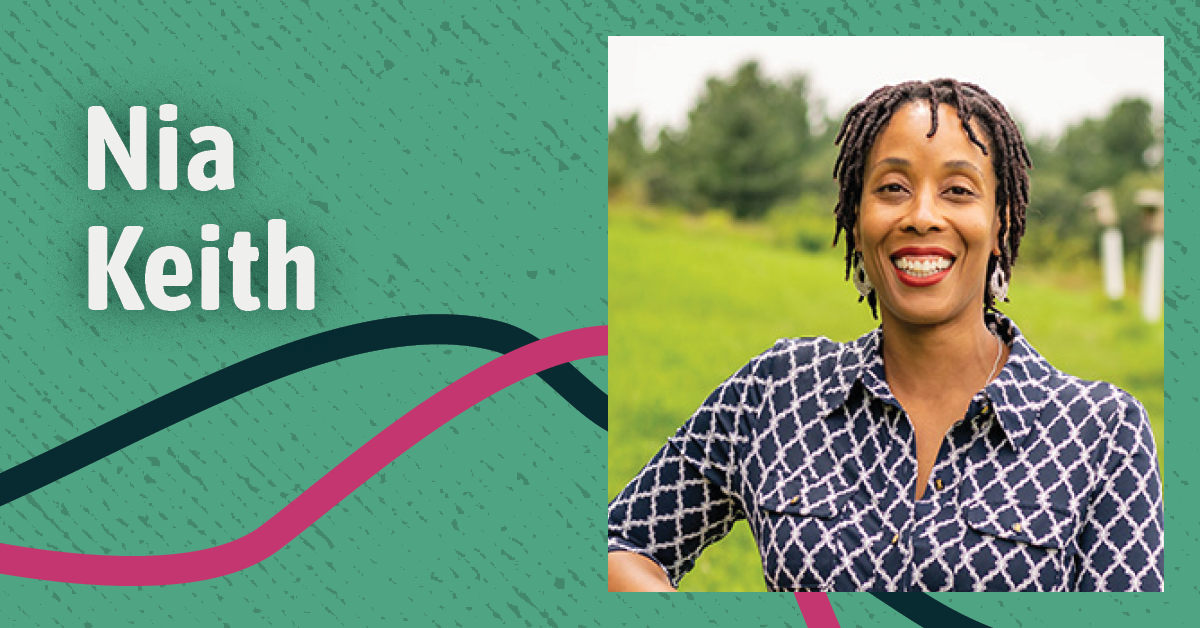Imagining a world in which the people working in environmental conservation reflect the diversity of life they aim to protect means imagining a world that’s not yet arrived. But things are changing, and Nia Keith, the new Vice President for Diversity, Equity, Inclusion, and Justice (DEIJ) at Mass Audubon, the largest nature-based conservation organization in New England, envisions a paradigm shift for the field.
She’s excited about working towards that in her new position. “The events of Freedom Summer 2020, following the public murder of George Floyd, changed a lot of things for environmental organizations. All around the country we saw an upsurge in people’s commitment to equity and justice. Positions like mine began to crop up everywhere and I couldn’t be more thrilled!” Keith says. Her goal in her new position is to recognize and combat systemic issues that have historically limited the influence of certain groups of people in the environmental movement, a factor that she believes has in turn limited the effectiveness of conservation efforts.
At the moment, she and her colleagues are focusing their attention on crucial areas that they believe will contribute to major change. Perhaps the most important is hiring and retention practices, an important aspect of which is increasing access to well-paying early career opportunities in environmental and conservation fields. Like many academically-driven, altruistic, mission-oriented career pursuits, conservation jobs (especially entry-level ones) are notorious for requiring a high level of commitment without a reciprocal level of compensation. People make these sacrifices because they care – passionately – but the low pay limits who can afford to.
Paying for the education, and the often unpaid or underpaid training, required to attain these positions costs both money and time and many find it impossible to support themselves and their families on the field’s typical salaries. For example, the median pay for a conservation scientist or forester in 2021 was about $63,000 per year. Part of the issue is that conservation, like education ($62k median salary for high school teachers), simply doesn’t have enough resources. Keith’s team hopes to center the voices and needs of people who have been marginalized in not only conservation work, but to also change the systems that have made the field inaccessible in the first place.
Keith is well aware of those limitations and more. “In more damaging instances, conservation measures have been used as a form of genocide, designed to separate Indigenous peoples from their land, infringe on their sovereignty, and weaken their communities,” she says. Some of the most pressing environmental issues we face as a nation are around climate change and relatedly, water: quality, availability, and the protection of resources. High-profile environmental injustices such as the crises at Standing Rock and Flint have received national attention, while long-running water-related environmental inequities like those occurring in some communities in Los Angeles are less visible. The goal is to build capacity for doing more equity-driven work in the future, but it is only a microcosm of sweeping change that needs to happen at the national (and international level) in service of universal environmental health and wellness.
A Spiritual Connection With Nature
Keith’s commitment to environmental justice runs deep. “So many things have inspired me along the way, but I think it started with Nature herself,” she says. “I have always been drawn to nature in a way that was beyond recreation, more than just enjoying playing outside. For me, the connection was always spiritual. By the time I was in high school, I was ready to devote myself to her protection as a career.”
Many experiences throughout her life have fed and reinforced this calling. In her early twenties, she did a volunteership in the Northeast through a joint AmeriCorps and Student Conservation Association program, for which she spent 10 months living in cabins in the woods of New Hampshire providing environmental education for middle school students, building trails in the White Mountains, and working on erosion control in the lakes region. The experience changed her life. Through it, she discovered that she’s an educator at heart, which led her to pursue many jobs in formal and informal education, and eventually a Master of Science degree in Environmental Studies with a focus on Environmental Education from Antioch University New England, graduating in 2009.
She now holds an executive position, but still identifies as an educator and introduces herself that way. Similar to the way that Antioch highly values life experience as education, Keith’s own experiences and perspectives serve as a career compass. “Of course, my lived experience has greatly shaped my career path,” she says. “I’ve seen the way my life and the lives of others around me are impacted by systemic oppressions. I’ve seen the way environmental abuse often goes hand in hand with human abuse. I’ve always been a fighter and so I think it was inevitable that I would build a career around addressing these issues.” Keith thinks being an educator goes hand in hand with a healthy appetite for learning. She would love to return to school to pursue a doctorate in Organizational Leadership & Change. “Thinking of pursuing another degree right now feels a little bit like playing double Dutch,” she says, “I’m just waiting for the right timing to jump in.”
Equity, The Cornerstone Of A Movement
Keith’s greatest hope is that the momentum for equity and justice that started in 2020 continues and builds over the next five to ten years, becoming a cornerstone of all the work in the environmental field. What she’d like to see is nothing less than a radical transformation of what it means to be an environmentalist. What might such a transformation look like? She’d like to see Black and Indigenous decision-makers at the heart of environmental conservation efforts, at the decision-making, system-changing level.
“For Black and Indigenous peoples in the United States, experiences with land have been particularly bittersweet,” Keith says. “Both groups have a history of forced removal from their ancestral lands and a history of forced labor on stolen land in this country.” She remarks that, despite this, both groups have always been profoundly connected to the land, often acting as stewards and cultivators. The current (and historic) gap between who makes decisions regarding the environment and who’s most directly affected by those decisions is as startling and heartbreaking as it is widely accepted as the status quo. That is what needs to change.
“The only way to rectify these wrongs is to center the voices, needs, and experiences of Black, Indigenous, and other People of Color in the environmental movement,” she says. “I want to see Black CEO’s in Big Green. I want to see Indigenous communities in charge of conservation plans. I want to see melanated people in charge of the money, the resources, the messages, etc. In other words, I’d like to permanently flip the paradigm of what it means to do environmental work in this country.”






